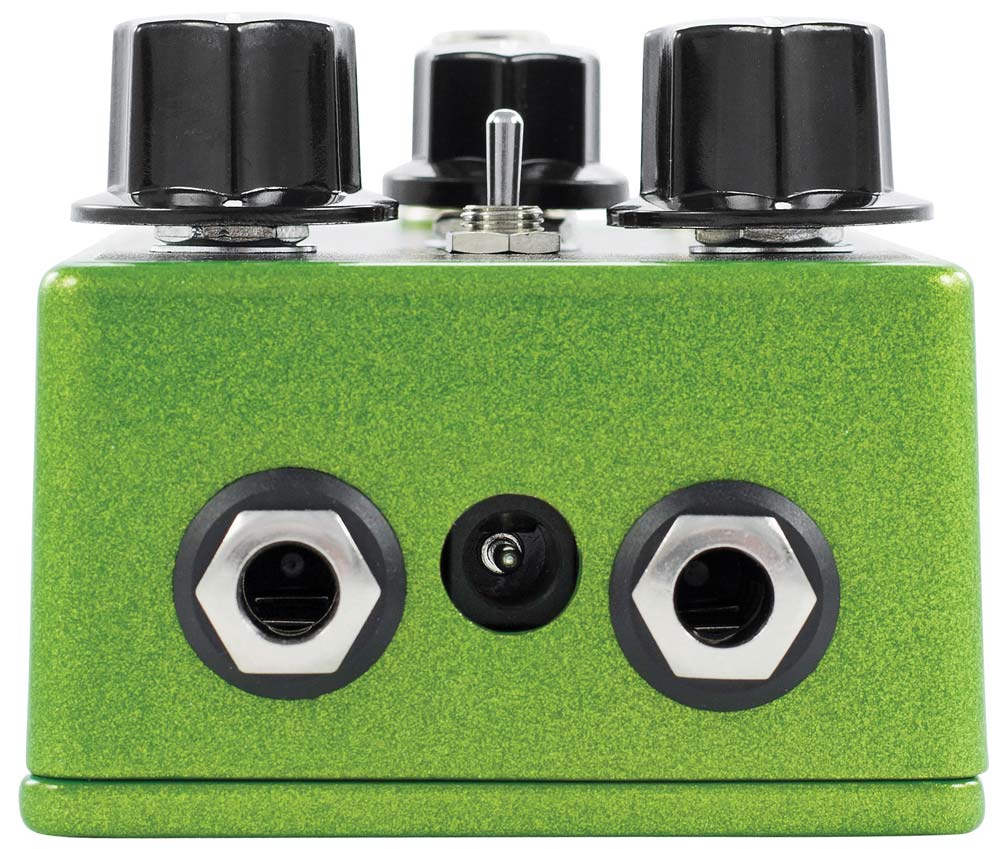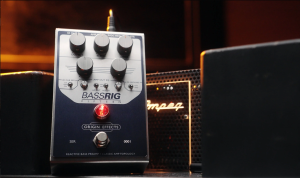Where Pulse Meets Power in the Low End
The Hummingbird is EarthQuaker Devices’ modern take on the vintage “repeat percussion” tremolo circuit — a choppy, percussive style of amplitude modulation that emphasizes square-wave tremolo, delivering a bold, on/off stutter rather than the smooth ebb of traditional sine or triangle-wave tremolos.
Originally derived from the Vox Repeat Percussion, the Hummingbird elevates the concept with a wider rate range, greater control over depth and volume, and excellent signal integrity, especially valuable when applied to bass guitar.
For bassists, this pedal can be an unexpected gem — providing pulsing rhythmic motion, synth-like textural effects, and a compelling way to modulate dynamics and groove.
Why Tremolo Works (and Shines) on Bass
Though often associated with guitar and surf rock, tremolo on bass offers unique advantages:
- Adds dynamic pulse to sustained notes without masking transients.
- Introduces movement and rhythmic modulation that complements drum grooves or sequencer patterns.
- Works beautifully in dub, ambient, funk, lo-fi, and experimental genres.
- Enhances spatial effects like delay and reverb by creating chopped echoes or strobing textures.
Square-wave tremolo in particular is powerful on bass — not just modulating volume, but shaping how a note breathes, disappears, and re-emerges in the mix.

Control Layout: Simple but Powerful
The Hummingbird features a minimal but interactive control set, letting you dial in everything from slow pulses to near audio-rate flutter.
Depth
- Controls the intensity of the tremolo.
- At low settings, the effect is subtle and throbby.
- At max, it becomes full-on stutter — almost a rhythmic gate.
- On bass, this is crucial for tailoring the effect to the role you want: background motion or front-line effect.
Rate
- Manual speed control for the tremolo modulation.
- Goes from slow, sweeping chops to rapid-fire trem pulses.
- Faster rates create textures that verge on glitchy or synthy, especially with fuzz or reverb.
Mode Switch (Three Speed Ranges)
- Mode 1 (Slow): Ideal for dub pulses, ambient swells, or traditional tremolo.
- Mode 2 (Medium): Most musical range — tight, rhythmic pulses.
- Mode 3 (Fast): Enters pseudo-ring mod or synth flutter territory.
- Mode 3 can also simulate sidechain compression-style pumping, especially in slower musical contexts.
Level
- Controls overall output volume.
- Essential on bass — helps compensate for perceived volume dips from amplitude modulation.
- Also lets you push your amp or pedalboard slightly harder, great for saturation stacking.
Tone and Response on Bass
The Hummingbird is surprisingly bass-friendly, retaining low-end integrity and punch even at high Depth or fast Rate settings.
- Does not thin out the signal, unlike some vintage tremolos.
- Works great with both passive and active pickups.
- Square-wave modulation adds percussive clarity without mud.
Its tonal character is raw and unapologetic — this isn’t a mellow, ambient trem. But with careful tweaking, it can be as much felt as heard, especially in subtle settings or when combined with ambient effects.

Effect Pairings: Building Sonic Layers
The Hummingbird is a team player on pedalboards — its rhythmic modulation interacts dynamically with nearly every effect type.
Fuzz & Overdrive (Before or After):
- Before dirt = tremolo impacts the gain structure, resulting in spitty, chopped distortion.
- After dirt = tremolo cuts the already-saturated signal, giving you synthy gating and pulse.
Envelope Filter:
- Tremolo before filter = modulation affects the envelope trigger.
- Filter before tremolo = dynamic tone sweep gets rhythmically chopped — great for funk, psych, or glitchy grooves.
Delay/Reverb:
- Placing Hummingbird before delay/reverb = rhythmic pulses become echoes.
- Placing it after = delay trails get stuttered and filtered, adding movement and dimension.
Modulation Effects:
- Phaser, flanger, or chorus before the Hummingbird results in rhythmic movement with modulation flavor.
- Combines especially well with subtle chorus to create a thick, shimmering pulse.
Parallel Signal Paths:
- Running the Hummingbird in a blend or parallel loop allows you to keep a solid dry bass tone while adding rhythmic pulse to your overtones or effects return.
Build Quality and Format
- Compact footprint, standard 9V center-negative power.
- All-analog signal path.
- True bypass switching.
- Classic EarthQuaker Devices build quality: solid construction, quality components, stylish screen-printed enclosure.
While not feature-stuffed, it’s reliable and expressive, with just enough tweakability to tailor to your playing without overwhelming the user.
Who It’s For
Ideal for bass players who:
- Want a rhythmic tool that adds motion without EQ-ing out low end.
- Play in dub, post-rock, lo-fi, psych, or experimental genres.
- Already have fuzz, filter, or reverb pedals and want something to animate those tones.
- Like pedals that double as compositional tools, not just tonal ones.
It’s less suited to players seeking gentle, sine-wave tremolo for classic rock ballads — but perfect for those leaning into character and contour.
Pros and Cons
Pros:
- Bold, punchy square-wave tremolo ideal for bass
- Retains low-end clarity across all modes
- Compact and rugged
- Three modes offer wide speed range
- Level control ensures mix presence
- Excellent synergy with fuzz, filter, and ambient effects
Cons:
- No waveform variety (only square-wave)
- No tap tempo or external sync options
- Depth and Rate need careful dialing to avoid over-chopping in a mix
- May be too aggressive for traditionalists or those seeking transparent tremolo
Conclusion: Rhythmic Texture Meets Low-End Strength
The EarthQuaker Devices Hummingbird is a masterclass in how a simple concept — on/off tremolo — can become an expressive and musical force when executed with clarity, character, and nuance.
For bass players, it’s a secret weapon — adding motion, pulse, and chopped rhythmic tension without compromising fundamental tone. Whether used subtly to animate long notes or aggressively to strobe through fuzz and delay, the Hummingbird elevates tremolo from novelty to creative staple.
It’s not a tremolo for everyone — but for those open to rhythmic exploration, it rewards curiosity with an endless pulse that breathes alongside your playing.
Let me know if you’d like a few suggested Hummingbird settings tailored to bass-driven genres or multi-effect setups.





